What to spend on marketing in 2021: A story of a digital revolution

As we turn the page on a year we would all like to forget, we look forward to more productive days ahead.
In our annual evaluation of marketing trends, we turn to the bellwether of marketing spending —the CMO Study (COVID Special Edition), published by Duke University, The American Marketing Association and Deloitte. This year, 58% of respondents were of companies with less than $500 million in revenue, suggesting a high level of relevance to private companies. There was profound change to the marketing landscape as a result of the pandemic, and the learnings from the CMO Study were illuminating.
The collision of coronavirus, digital transformation, machine learning and performance-based marketing has set the stage for an environment where marketers can better prove return on marketing investment (ROMI).
Customer priorities changed in 2020. In relative terms, customer preferences shifted from seeking innovative suppliers who provided excellent service to brands they could trust, who were willing to sell to them at lower prices. Reputation marketing is king.

Source: The CMO Survey from Duke University, Special Covid-19 Edition
Marketing spend %
Rapid adoption of digital was evident, especially in B2B. Facing a void in traditional sales and marketing approaches such as trade shows and face-to-face meetings, B2B marketers were forced to adapt.
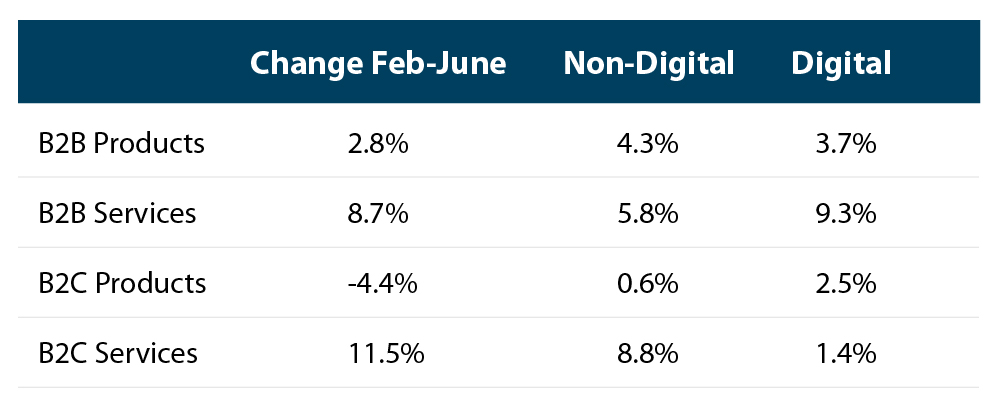
Source: The CMO Survey from Duke University, Special Covid-19 Edition
We note that CMO Study participants are likely to spend more on marketing (as they have Chief Marketing Officers) than perhaps the average company, but the study provides a valid benchmark from year to year. In a period of declining sales, marketing investment as a percentage of revenue increased from 8% pre-pandemic to more than 11% during the height of it. In part, companies wanted to maintain a connection between their brand and their customers.
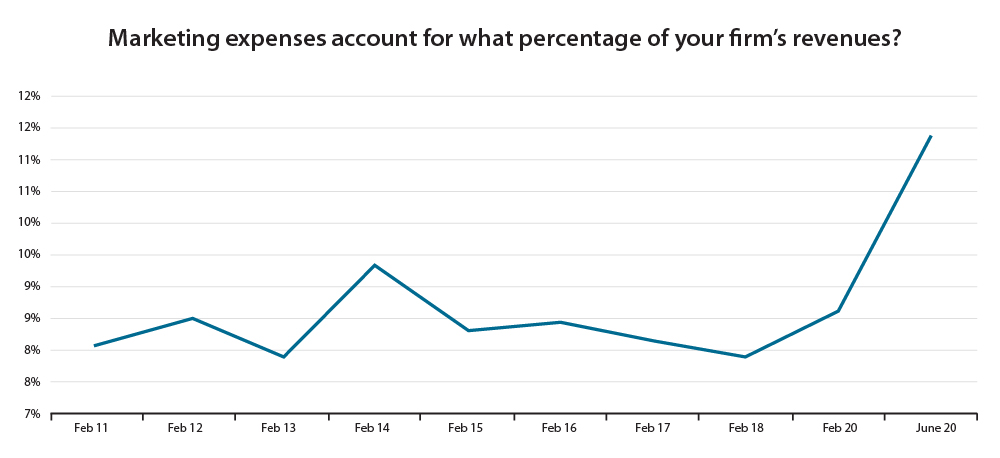
Source: The CMO Survey from Duke University, Special Covid-19 Edition
Shifts in investment
Given the realities of social distancing, certain sales activities will give way to marketing. Bill Gates recently estimated that upwards of 50% of business travel will be curtailed. This leads to perhaps the key insight we can take from the study. All indications point to a continued shift from traditional sales and marketing approaches to performance marketing —which is becoming increasingly more measurable and reliable.
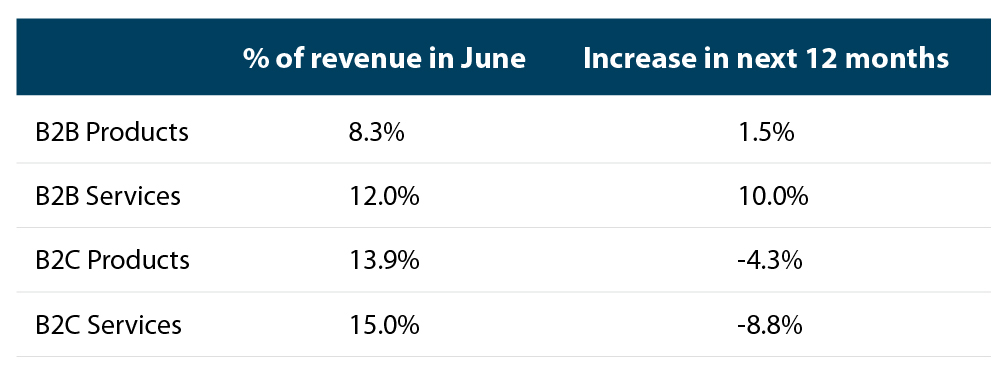
Source: The CMO Survey from Duke University, Special Covid-19 Edition
Unsurprisingly, it is B2B marketers who are forecasting higher spend headed into 2021. It should also be noted that services typically attract higher marketing investment because companies selling subscriptions are incented to acquire new customers who have a higher lifetime value. It is not uncommon of SaaS (software as a service) companies to spend upwards of 40-50% of their revenue on marketing early in their life-cycle. As a larger proportion of our economy shifts to cloud, marketing as a percent of revenue is likely to grow.
It is of little surprise that digital spending is coming directly from traditional advertising.
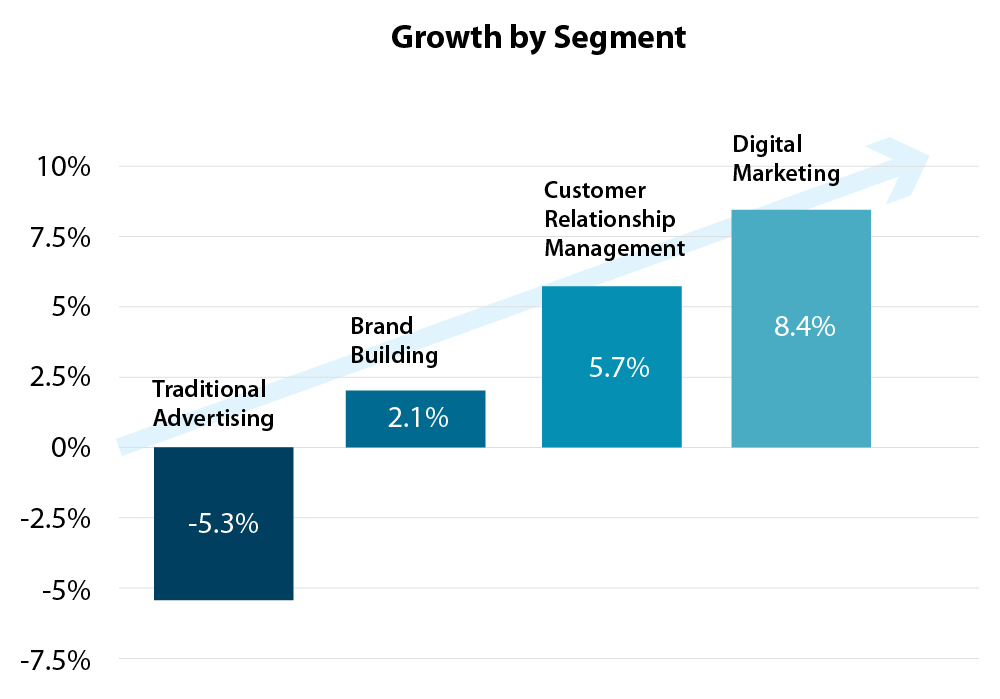
Source: The CMO Survey from Duke University, Special Covid-19 Edition
Similar to last year, customer relationship management is also growing at a healthy clip given the rise of marketing automation. Today, the marketer has the luxury of tracking the movements of a visitor through their website, picking up snippets of data about them along the way. By the time a prospect engages with a salesperson, they are armed with significant information about the customer’s preferences.
Based on a prospect’s behavior, messaging can be tailored to the customer’s needs throughout their customer journey. Specific statistics aimed at boosting conversion and customer lifetime value can be measured to improve performance. The trend toward targeting will only magnify shifts toward specialized product offerings, which is long underway.
Thus, the promise of performance marketing is to create sustainable predictable revenue. Our best clients can predict their revenue months in advance.
Testing can be used on unlock value, by isolating the tactics that get the greatest return. The next frontier will be machine learning and artificial intelligence, capable of interpreting customer movements and changing everything from photographs, descriptions, placement and promotions based on real time data.
Shockingly, only about one in three marketers today is taking part in A/B testing. Once a marketer has identified an ideal market, customer and product they can disproportionately deploy resources, as to optimize the results.
For example, the marketer can get a greater return on a search string such as “school construction California”, than “construction”. She could also isolate spend on trade shows, testimonial videos and white papers about that niche, only amplifying positioning as an expert in that specialty.
Marketer focus is also shifting toward client-facing technologies. In some cases, the pandemic completely altered how companies go-to-market, often shifting away from activities that require human interaction. Technologies such as chatbots that drive self-service are gaining momentum. Whenever possible, companies are replacing people with machines.

Source: The CMO Survey from Duke University, Special Covid-19 Edition
Marketers are also utilizing multiple modalities to influence prospects and customers. While B2C companies are gravitating to Instagram and Facebook, B2B companies are focusing on blogs and LinkedIn for influencer marketing. LinkedIn has emerged as a favorite for B2B marketers who can build online events, target based on specific search terms, start online user groups, and build their database en masse.
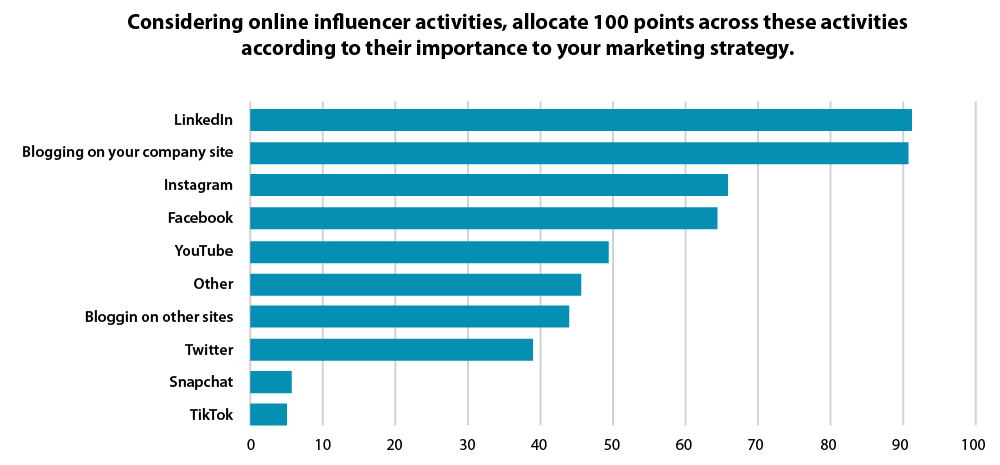
Source: The CMO Survey from Duke University, Special Covid-19 Edition
Consumers are searching for brands they can trust — 79% of them acknowledged marketers’ attempt to “do good.” While many big brands took a stand in 2020 on various issues, only one in five marketers think they should be taking positions on sensitive political issues.
8 actions you should take to participate in digital transformation
Below are recommended actions for businesses that don’t want to be left behind.
1. Build the necessary resources. As we chronicled in our recent trend series, the IT departments of tomorrow will need to have the capabilities to build custom applications, including those used by marketing to manage customer interactions and conversion. Marketing departments will have to be digitally savvy and capable of managing SEO, influencer marketing, video and mobile. Almost half of 2021 marketing spend will be in digital assets.
2. Map the customer journey. Every sales and marketing team should map each step of the customer journey and understand what information should be delivered at every touch point. Further, sales and marketing should agree on which roles shepherd which responsibility every step of the way.
3. Publish performance statistics. Sales and marketing key performance indicators (KPIs) should be published as a predictive indicator of demand.
4. Be targeted with content. Today’s drip campaigns should be organized by specific targets based on what the marketer has learned about them.
5. Test and measure effectiveness. Know thy numbers. Every company should know their cost of acquisition, conversion rates and lifetime value. Use A/B testing to evaluate what works. Learn which levers you can pull with precision.
6. Help hire the people who will contribute to your company’s success. Employer branding was hot before the pandemic and will be hot again. Carve out part of your marketing team to support HR in employer branding.
7. Use marketing to influence the customers you already have. Increasingly, marketers are looking to create a level of connectedness to their existing customers. The need for the comfort of known brands was magnified during a time when people were motivated by fear. Use facts to reassure your audience that your brand is the one to be trusted during times of chaos.
8. Be prepared for the dip and the rebound. It’s going to be a long winter as COVID cases are expected to peak in late February. Companies will have to rely on providing digital solutions. But those who are successful should see a rebound effect in the spring, as they experience double-digit increases against a soft quarter last year. Best-in-breed companies will continue to invest so they can isolate opportunities and be prepared for the upswing.
To a better year ahead.
Related resources
Category: Marketing
Tags: coronavirus, marketing plans

